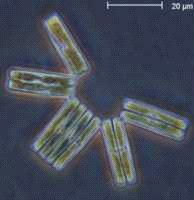|
|
 |
1. Phytoplankton
Dimethyl sulphide is a climatically important gas which is produced by phytoplankton.
What are phytoplankton?
|
 |
 |
1. Coscinodiscus radiatus. Photo: NASA |
|
 |
 |
 |
2. Oscinodi thalassionema nitzschoides scus.
Photo: NASA |
|
2. Positive climate feedback loop
Describe a positive climate feedback loop involving methane and eutrophication.
3. Oceanic source of nitrous oxide and climate
How is the oceanic source of nitrous oxide likely to be affected by climate change and how, in turn, does nitrous oxide affect stratospheric ozone levels?
4. Ocean color |
|
Phytoplankton contain the pigment chlorophyll which allows them to photosynthesise. Because they contain chlorophyll, phytoplankton are very important in determining the colour of the ocean. High concentrations of phytoplankton means more chlorophyll which, in turn, makes the oceans look green.
|
 |
 |
|
3. The colour scale used to make chlorophyll concentration measurements (in mg m-3) from space using instruments mounted on satellites.
|
|
Below are two satellite images of the oceans from space. The different colours in the ocean represent the different concentrations of phytoplankton. These satellite measurement techniques allow us to look at plant life in all areas of the ocean.
Use the scale above to determine the chlorophyll concentrations in various ocean regions.
|
 |
 |
|
4. This satellite image shows ocean colour in the summer (June-August 1998) in the Northern Hemisphere. Photo: NASA.
|
 |
 |
|
5. This image shows a phytoplankton bloom in the middle of the North Atlantic Ocean and very high chlorophyll levels in the coastal waters around Northern Europe. Photo: NASA.
|
About this page:
authors: Dr. Ellen K. Henriksen and Camilla Schreiner - University of Oslo, Oslo, Norway
scientific reviewer: Dr. Lucinda Spokes - School of Environmental Sciences, University of East Anglia, Norwich, U.K.
last update: 2004-03-27
|
|
 |
|







